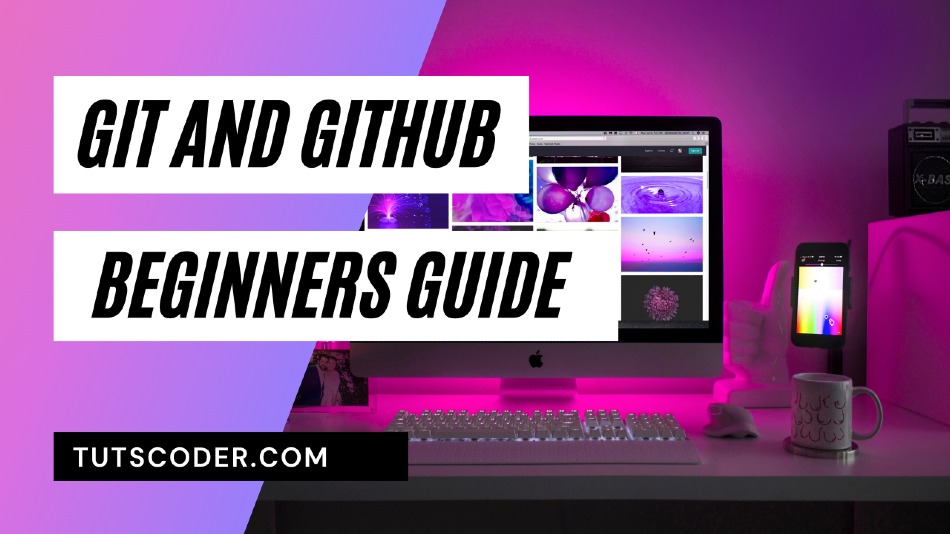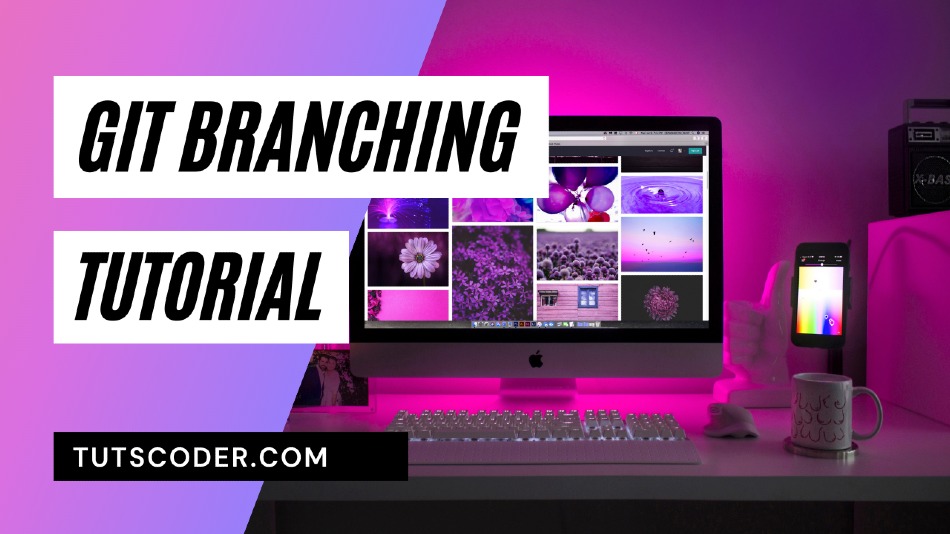
How to Develop a Nutrition App Excluding Inaccuracy
Living in a reality of hyper-productivity and caring about health can be accidentally lost, among other priorities.
However, people are interested in being fit and healthy, and that’s why a quality nutrition & diet app may become an indispensable tool for life quality improvement.
Who Uses Nutrition Apps?
First, such apps help you learn more about your organism and food consumption. People often use it daily to start eating healthier or keep themselves hydrated enough.
Usually, they contain personalized features that help users develop healthy relationships with food and may help build customized nutrition plans for people who suffer from diseases like type II diabetes.
Main Features of the Nutrition App
Every fitness and nutrition app should have some essential features to be competitive and functional. Let’s learn the core functionalities of such solutions.
Registration Health Questionaire
Besides the basic signing-up process via email, Apple, or Google, any nutrition app needs to specify your current state data.
Here are the main questions usually asked:
- User’s age
- Current weight
- Height
- The purpose of using an app (weight loss, weight gain, or keeping current weight)
- Desired weight (if it’s about weight loss or weight gain)
- User’s diet (vegetarian, vegan, regular, etc.)
- Allergies
- Time the user is ready to spend on the workout (optionally)
While developing this module, make sure that you let users choose measurement units.
Meals and Beverages Range
However, such apps are primarily about food and the control of its intake. A dictionary with a wide range of food, dishes, and beverages must be included accurately. Don’t forget about the advanced default calories counter!
If the range is not completed correctly, the problem of ‘amateur’ counts may occur, which won’t attract users much.
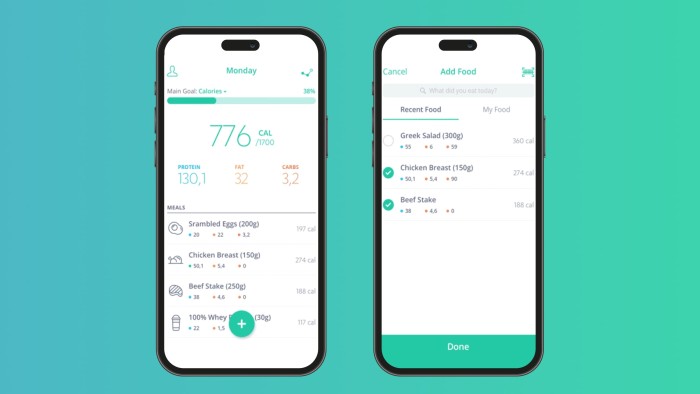
Dashboard
One of the main parts of your nutrition app. This should be the first thing the user sees entering it.
It is directly connected with food logging because users can examine the rest of the calories left for the daily norm or, for example, statistics for weekly food intakes, workouts, etc.
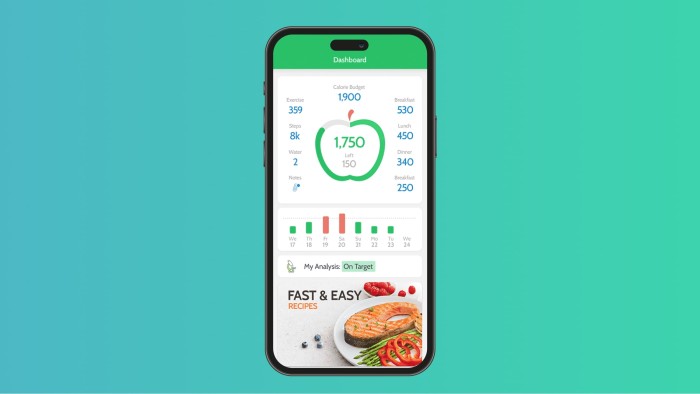
Healthy Lifestyle Gamification
Even if a user sets a solid goal, it may be hard to be on track with no tangible outcomes all the time. That’s why it is essential to engage users through gamification and not to let them return to their previous lifestyle.
It works excellently with a workout routine. You can try to implement a level system, and each time a user trains for a week straight, he or she receives a level-up. Level-ups or other bonuses can lead to a free week of access to premium workout or nutritional plans.
Apps like Streaks and Playfitt are already using this technique successfully.
Collaborate With External Trackers
You may have a question about how to extract user physical activity data.
Integrating your app with multiple external trackers like AppleWatch, Xiaomi Mi Smart Band, Samsung Galaxy Watch, and other options is the answer. The more devices you can maintain, the more inclusive your app will be.
Appropriate Notifications
It’s a gentle way to remind users about their meal schedule or essential water intake. However, don’t try to knock out this idea directly into the user’s brain. Become a friend that just reminds but not forces.
Help
If a user suddenly gets lost among multiple features, you always appear by their side with a question mark button. It will simplify the interaction process with users and invest in building a little trust bridge between you and your customers.
After adding all the must-have features, you should consider something more special.
Additional Features
Interactivity definitely won’t harm your product. For example, you can add that to make the user experience more advanced:
- Create a massive community : Turn your nutrition app into a social network. Let people interact with each other, share photos, and share progress in living healthily
- Connect users to a real nutritionist : No app can replace a real professional. Sure, you can supply users with general well-being advice, but consider adding the ability to connect with a real doctor via chat, video consultation, etc.
- Custom recipes : It’s a great idea to diversify users’ regular diets. Also, you can offer diet recipes for regular meals to make the transition of eating habits smoother
- Barcode scanner : It’s an easy way to learn about food parameters. This will help users to follow their diet easily.
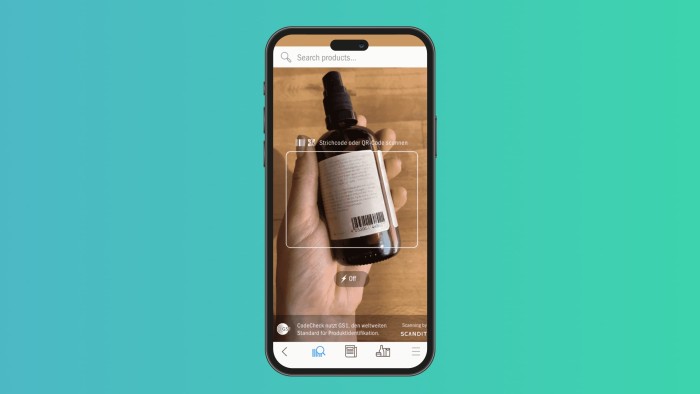
Creating Nutrition App Step-by-Step
Knowing the technical aspects that will help you create a product is good, but knowing how to implement it is better. Here are some things you should consider developing an app:
Professional team
App development, in general, is impossible without a team. They will help you implement a project from idea to launch. For example, if you plan to build a diet and nutrition app targeting Android users, you should hire an Android app developer to build such a solution.
Also, it’s good to optimize your product for Android and iOS systems to serve more customers, thus, increasing business income
Discovery Phase
It’s time to gather all information, including the main goals, and outline the project ideas. After this, an expert team will provide you with a project estimate.
UI/UX Design
After this, UI/UX designers start to work on your product’s structure and appearance. They create a unique, eye-catching look that will attract customers and suit your corporate style.
Development
During a certain agreed period of time, developers work on the cortex of your future app. The time length may differ according to the type and scale of the product.
Quality Assurance
At this stage, QA engineers are testing general functionality, and in case of malfunctions, they report to developers, who try to fix it fast and qualitatively.
Maintenance and Release
Last but not least. After ensuring the product runs well, it’s ready to be released. However, cooperating with your teams is not usually over at this stage.
It is needed to maintain the application in the future and to develop some advanced updates.
Monetization Models
Premium Model
This model implies that the customers directly pay for your product. But some difficulties occur here: The nutrition app market is overcrowded, and it may be hard to impress the consumer.
However, you can smooth angles by showing customers what your product is capable of and then offer to go premium to access more functions.
Free model
It’s a prevalent strategy today. The app is free, but users sometimes have to watch ads or make internal purchases(removing ads, buying unique features, etc.)
Well, It’s Time To Get To Work!
The idea of developing a nutrition app is great. And the market has shown a considerable demand among people struggling to improve their lives.
Hopefully, this post will help you make informed conclusions and inspire you to develop a truly spectacular diet and nutrition application.



